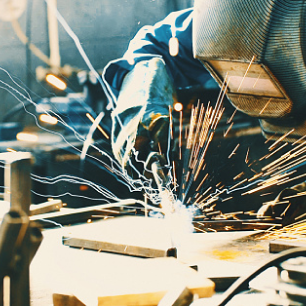Jump to:
IEC 2023: Inspection Expo & Conference Highlights
After a two-year break because of the pandemic and other factors, four organizations at last came together to present at the Inspection Expo & Conference (IEC) at the Renaissance Austin Hotel in Austin, Tex., from November 8 to 10, 2023. The Association for Materials Protection and Performance (AMPP), the American Institute of Steel Construction (AISC), the Nondestructive Testing Management Association (NDTMA), and the American Welding Society (AWS) offered a staggering 62 sessions that catered to the wide diversity of the attendee’s backgrounds and expertise. The exhibit hall provided sponsors, exhibitors, panelists, and attendees ample opportunities to network.
Presentations focused on welding inspection, nondestructive examination (NDE), coating inspection, and structural steel inspection, and some of the topics covered were auditing, phased array ultrasonic testing (PAUT) applications, inspection of complex coatings, metallurgy, mechanical testing, bridge infrastructure, digital transformation, remote visual inspection, advances in robotic NDE, offshore corrosion, changes in welding codes, and the business of inspection, to name a few.
Keynote
After the Presentation of Colors by the award-winning Area 18 Distinguished Unit Navy JROTC from Stony Point High School, Round Rock, Tex., AWS Past President Richard Polanin introduced the opening keynote speaker. Greg “Boss” Wooldridge is the only commanding officer to lead the Blue Angels for three separate tours. Using his experiences as examples, Wooldridge discussed how teams should build on communication, trust, and collaboration rather than rank and status. Wooldridge explained his approach to the dynamics of debriefing: a safe environment, humility, openness, accountability, and gratitude. His “Glad to Be Here” philosophy is based on concepts such as making continuous improvement a habit, alignment, team oneness, an honest and engaged environment, and a high-performance culture of excellence. It was interesting to draw parallels between his leadership concepts as a pilot and commander and the situations inspectors frequently encounter.
AWS Sessions
The conference not only provided a mix of topics related to inspection specialties that cater to specific professionals, but it also offered a cross-reference hub for attendees to learn about the advances and challenges of the other inspection areas. An ongoing theme of the IEC is that many inspection areas are related, and different industries as well as individual inspectors or companies can benefit from collaborating and learning from each other. Many sessions touched on the benefits (and challenges) of inspectors holding multiple certifications.
The following are summaries of a few AWS breakout sessions at the conference.
Welder Qualification – What a CWI Needs to Know
By Scott Witkowski, vice president of Republic Testing Laboratories and IEC organizing committee member
To maintain a low reject rate on production welding activities in the shop, field, or manufacturing floor, there are many factors AWS Certified Welding Inspectors (CWIs) must understand when testing welders and before starting welder qualifications. Witkowski pointed out the importance of not only having certified personnel but also qualified personnel. He explained that because technology, techniques, and codes change constantly, continuous education is essential to address the gap in learning and experience. A takeaway from this session was the importance of welders knowing the code they are welding to. Code requirements differ; therefore, each project, job, or application requires the appropriate qualification. Witkowski also spoke about the benefits of mockups (which may be costly but can be the best insurance policy), proper training, and allowing the welders to practice and become proficient in the skills necessary for the specific weld requirements. All these components have a significant impact on a job’s success.
CWI’s Role and Considerations in Reviewing Prequalified/Qualified WPSs and WPQs for the AWS D1.1 Code
By Richard Holdren, AWS vice president and future AWS president (2025)
Among the tasks a CWI performs per AWS D1.1, Structural Welding Code — Steel, are verifying welding procedure specifications (WPSs) and welder performance qualifications (WPQs). These documents ensure the soundness of the weld and welding by detailing the procedure’s essential variables, which include the materials and processes used and the manner in which the processes are applied. Holdren remarked how position is also a very important essential variable of the procedure qualification. The session offered an overview of the requirements for writing prequalified and qualified WPSs, WPQs, and welder procedure qualification records (PQRs). The presenter encouraged attendees to investigate the Welding Performance Qualification (WPQ1) and Welding Procedure Qualification (WPQ2) endorsements for proficiency in these tasks.
Changes in Welding Codes and Standards Relating to Inspection and Certifications
By Richard Campbell, a Bechtel fellow and welding technical specialist at Bechtel Corp.
This presentation discussed recent changes in AWS D1.1 and other AWS welding codes and standards relating to inspection requirements. The 2020 D1.1 edition now contains five options for visual inspector certifications, requirements for assistant inspectors, revisions to visual acuity requirements to align more closely with the American Society for Nondestructive Testing (ASNT), and advanced NDE techniques. Current requirements in the American Society of Mechanical Engineers (ASME) B31 piping codes and Boiler and Pressure Vessel Code regarding visual and NDE inspections and certifications were reviewed, along with American Petroleum Institute (API) 1104, Welding of Pipelines and Related Facilities, and other standards.
Campbell explained how each welding code and standard has its requirements for inspection and examination (and inspectors/examiners), and each has different requirements based on loading condition, fluid service category, and joint category that must be communicated to the welder and inspector. Various editions of the same code may have differences regarding inspection/examination and the acceptance criteria. He emphasized the importance of knowing what codes or standards (and the appropriate editions) apply to the contract or project.
Weld Cracking – Why Did It Crack?
By William F. Newell Jr., AWS director-at-large; president and welding consultant of W. F. Newell & Associates Inc.; and cofounder, co-owner, and vice president of engineering at EUROWELD Ltd.
Newell explained how the cause of cracking is usually attributed to design, base metal, welding consumable, or welding technique issues. He also mentioned that management could contribute indirectly to cracking because of the restrictions on time and hiring they may impose. Typical cracking mechanisms include hot cracking (welding and solidification), cold cracking (service or stress), corrosion induced (process fluid or environment), and others, such as processing or heat treatment. He discussed how groove geometry and bead shape matter, and how preheat, welding, and postweld heat treatment are only sometimes predictable.
Radiographic Image Quality Compliance and the Role of the CWI
By Amanda L. Young, ASNT Level III, AWS CWI, and vice president of McNDT Pipeline Ltd.
The role of the CWI is changing, requiring a wider scope of skills that cover different welding-related responsibilities. It is progressively common for clients to require CWIs to manage a broad set of operations related to welding, including oversight of NDE and quality. Participants weighed in on how clients often need clarification on what CWIs are qualified to do. For example, although CWIs might have the pertinent skills, they are only officially qualified to interpret radiographic images if they possess the appropriate certification. Also, it’s essential that if a CWI oversees the NDE, they work with the onsite representative to ensure the expectations are aligned with the contract and that the CWI is clear on the deliverables (i.e., reports and images). Furthermore, CWIs should not be working in the capacity of an ASNT Level III auditor. Young closed by stating that CWIs must ensure efficiency and quality, and they are uniquely positioned to bridge trust between the client and other NDE contractors on-site. She recommended CWIs seek an AWS Certified Radiographic Interpreter (CRI) credential to expand their knowledge of this method, which may aid them in overseeing NDE.
CARLOS GUZMAN (cguzman@aws.org) is managing editor, digital and design, and Inspection Trends editor, AWS, Miami, Fla.


